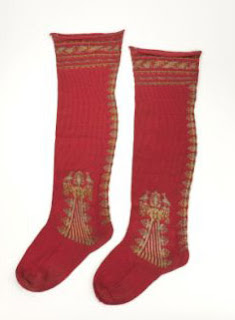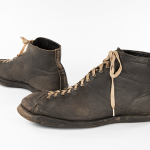By Senior Curator Elizabeth Semmelhack
Here in Canada the time of year has arrived when we add something to our wardrobes which have been absent for some months – socks! What is cosier than slipping into a pair of hand-knit socks. But socks are not just for warmth – for thousands of years, people around the world have sought to separate themselves from their shoes with all manner of shoes. Some are humble, some are splendid, but all were created to make us more comfortable as we walk through life.
| Replica of Otzi man’s shoe, 2002 |
When the 5300 year old Otzi man’s body was found in the Alps in 1991, not only has his body been preserved but so had his clothing, including his shoes and ‘socks’. The socks were really bunches of grass that Otzi had stuffed into a netting made of linden bast. Dr. Peter Hlavacek, the Czech researcher who had worked on the Otzi mans’s shoes, made this replica for himself to see how well the shoes and grass functioned. After hiking in his replica shoe, Hlavacek said that the grass worked very well as an insulator and wicked moisture away from his feet. Grass has been used by many different peoples around the world either simply stuffed into their shoes, or intricately woven into socks.
 |
|
| Possibly Spanish , 17th century |
Knitting was introduced into Europe by the Moors who rules Spain from the 8th to the 15th centuries. Finely knit silk stockings became a highly desirable Spanish speciality. Queen Elizabeth is said to have declared that she would never again wear linen hose after trying on a pair of Spanish silk stockings. This pair of hand-knit silk stockings is probably Spanish and was made to be worn by a very wealthy child. The stockings were made using sold threads that had been dyed red, which was the most expensive dye in the 17th century. The use of silver and gold gilt thread also suggests that the wearer was well off.
Want to learn more? Check out online exhibition, SOCKS: Between You and Your Shoes that is now available on our website here.


